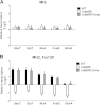Characterization of a novel two-component regulatory system, HptRS, the regulator for the hexose phosphate transport system in Staphylococcus aureus
- PMID: 25644013
- PMCID: PMC4363416
- DOI: 10.1128/IAI.03109-14
Characterization of a novel two-component regulatory system, HptRS, the regulator for the hexose phosphate transport system in Staphylococcus aureus
Abstract
Hexose phosphate is an important carbon source within the cytoplasm of host cells. Bacterial pathogens that invade, survive, and multiply within various host epithelial cells exploit hexose phosphates from the host cytoplasm through the hexose phosphate transport (HPT) system to gain energy and synthesize cellular components. In Escherichia coli, the HPT system consists of a two-component regulatory system (UhpAB) and a phosphate sensor protein (UhpC) that tightly regulate expression of a hexose phosphate transporter (UhpT). Although growing evidence suggests that Staphylococcus aureus also can invade, survive, and multiply within various host epithelial cells, the genetic elements involved in the HPT system in S. aureus have not been characterized yet. In this study, we identified and characterized the HPT system in S. aureus that includes the hptRS (a novel two-component regulatory system), the hptA (a putative phosphate sensor), and the uhpT (a hexose phosphate transporter) genes. The hptA, hptRS, and uhpT markerless deletion mutants were generated by an allelic replacement method using a modified pMAD-CM-GFPuv vector system. We demonstrated that both hptA and hptRS are required to positively regulate transcription of uhpT in response to extracellular phosphates, such as glycerol-3-phosphate (G3P), glucose-6-phosphate (G6P), and fosfomycin. Mutational studies revealed that disruption of the hptA, hptRS, or uhpT gene impaired the growth of bacteria when the available carbon source was limited to G6P, impaired survival/multiplication within various types of host cells, and increased resistance to fosfomycin. The results of this study suggest that the HPT system plays an important role in adaptation of S. aureus within the host cells and could be an important target for developing novel antistaphylococcal therapies.
Copyright © 2015, American Society for Microbiology. All Rights Reserved.
Figures






Similar articles
-
Coordinated regulation of transcription by CcpA and the Staphylococcus aureus two-component system HptRS.PLoS One. 2018 Dec 12;13(12):e0207161. doi: 10.1371/journal.pone.0207161. eCollection 2018. PLoS One. 2018. PMID: 30540769 Free PMC article.
-
Regulatory mechanism of the three-component system HptRSA in glucose-6-phosphate uptake in Staphylococcus aureus.Med Microbiol Immunol. 2016 Jun;205(3):241-53. doi: 10.1007/s00430-015-0446-6. Epub 2015 Dec 28. Med Microbiol Immunol. 2016. PMID: 26711125
-
Elevated Expression of GlpT and UhpT via FNR Activation Contributes to Increased Fosfomycin Susceptibility in Escherichia coli under Anaerobic Conditions.Antimicrob Agents Chemother. 2015 Oct;59(10):6352-60. doi: 10.1128/AAC.01176-15. Epub 2015 Jul 27. Antimicrob Agents Chemother. 2015. PMID: 26248376 Free PMC article.
-
Approaches used to examine the mechanism and regulation of hexose transport in rat myoblasts.Biochem Cell Biol. 1986 Nov;64(11):1081-91. doi: 10.1139/o86-143. Biochem Cell Biol. 1986. PMID: 3548754 Review.
-
Role of two-component systems in the resistance of Staphylococcus aureus to antibacterial agents.Virulence. 2011 Sep-Oct;2(5):427-30. doi: 10.4161/viru.2.5.17711. Epub 2011 Sep 1. Virulence. 2011. PMID: 21921684 Review.
Cited by
-
L-arginine supplementation abrogates hypoxia-induced virulence of Staphylococcus aureus in a murine diabetic pressure wound model.mSphere. 2024 Mar 26;9(3):e0077423. doi: 10.1128/msphere.00774-23. Epub 2024 Mar 1. mSphere. 2024. PMID: 38426801 Free PMC article.
-
Coordinated regulation of transcription by CcpA and the Staphylococcus aureus two-component system HptRS.PLoS One. 2018 Dec 12;13(12):e0207161. doi: 10.1371/journal.pone.0207161. eCollection 2018. PLoS One. 2018. PMID: 30540769 Free PMC article.
-
Comparative Genomic and Pan-Genomic Characterization of Staphylococcus epidermidis From Different Sources Unveils the Molecular Basis and Potential Biomarkers of Pathogenic Strains.Front Microbiol. 2021 Nov 15;12:770191. doi: 10.3389/fmicb.2021.770191. eCollection 2021. Front Microbiol. 2021. PMID: 34867904 Free PMC article.
-
Revisiting old friends: updates on the role of two-component signaling systems in Listeria monocytogenes survival and pathogenesis.Infect Immun. 2024 Apr 9;92(4):e0034523. doi: 10.1128/iai.00345-23. Epub 2024 Mar 4. Infect Immun. 2024. PMID: 38591895 Free PMC article. Review.
-
Systematic Reconstruction of the Complete Two-Component Sensorial Network in Staphylococcus aureus.mSystems. 2020 Aug 18;5(4):e00511-20. doi: 10.1128/mSystems.00511-20. mSystems. 2020. PMID: 32817385 Free PMC article.
References
Publication types
MeSH terms
Substances
Grants and funding
LinkOut - more resources
Full Text Sources
Other Literature Sources
Medical
Molecular Biology Databases

